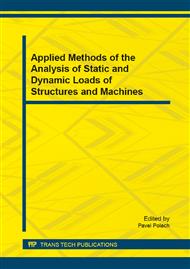p.153
p.161
p.165
p.171
p.175
p.179
p.183
p.187
p.191
Static and Dynamic Experimental Stress-Strain Analysis of Axles Loaded by Rotation Bending
Abstract:
Safety assessment of railway axles is based on fatigue strength design. During the design overall lifetime, railway axles undergo a very high number of loading cycles under rotating bending. Due to safety and reliability reasons, fatigue strength design has to be very carefully evaluated. Both theoretical modelling and extensive experimental fatigue testing including full scale tests have to be performed, whereas such tests have to be performed correctly with a high precision. In the paper, problems of dynamic forces during fatigue tests of railway axles are pointed out. Though static calibration can be carried out with a very high precision, dynamic forces can cause a significant redistribution of static stresses along the axle. An example is given and discussed.
Info:
Periodical:
Pages:
175-178
Citation:
Online since:
February 2015
Authors:
Keywords:
Price:
Сopyright:
© 2015 Trans Tech Publications Ltd. All Rights Reserved
Share:
Citation:


